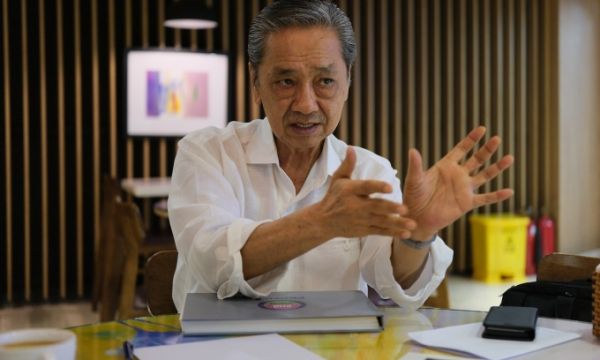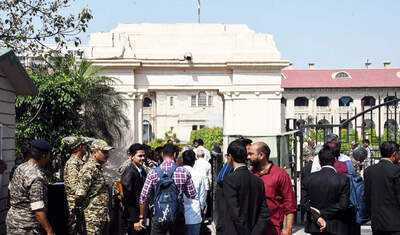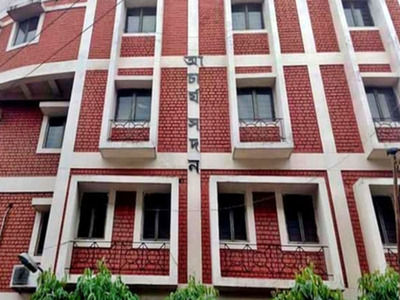
Amid the patriotic fervor accompanying the 80th National Day celebrations, Huynh visited his son in Vietnam last month.
During his trip he stopped by Pho 2000 and two hotels on Le Thanh Ton Street.
Seated in the lobby of the Avanti Hotel and watching foreign tourists pass by, he seemed to relive memories of 36 years ago when Vietnam’s tourism industry was still in its infancy and opportunities were limited.
In April 1989, as Vietnam entered the third year of its Doi Moi economic reforms, Huynh visited his homeland for the first time in nearly two decades.
The country was facing major challenges. The U.S. maintained its embargo, travel procedures were strict, the economy was plagued by shortages, and foreign investment laws were inadequate.
For overseas Vietnamese like Huynh, traveling home was especially difficult. Those holding U.S. passports could not obtain visas directly, and had to apply in Thailand.
“Thailand benefited a lot from overseas Vietnamese returning to Vietnam at that time,” Huynh recalls.
Most travelers stayed in Bangkok for two nights, spending money on food and lodging, while Vietnam was still struggling to take its first steps in tourism and services.
Overseas Vietnamese who wanted to visit home were required to come in controlled tour groups and seek permission for every place they wished to visit.
Arriving in Hanoi with a group of overseas Vietnamese, Huynh’s first instinct was to find a bowl of pho.
But at that time few restaurants had beef pho on their menu since cattle was still used for draught work and rarely slaughtered, and they mainly served chicken pho.
Coffee was even harder to find, available mostly in hotels, while street vendors typically sold only iced tea.
What left the strongest impression on Huynh was not the food but the people.
At the Hoa Binh Hotel, when he ordered several dishes, the staff advised him to “order a little at a time, finish everything, and then order more, otherwise it would go to waste.”
When he tried to leave a tip, the staff returned it, saying he had forgotten his money.
He says: “At that time I was very surprised, but I realized it reflected the sincerity of service workers, who did not put revenue first. It was a very Vietnamese kind of beauty.”
The turning point in Huynh’s career came on his second day in Hanoi when he was invited to the Ministry of Foreign Affairs to meet Minister Nguyen Co Thach and Deputy Minister Vu Khoan.
The two welcomed him warmly, offering a cup of Thai Nguyen tea, local candies and candid conversation.
Thach told him: “You are successful in the U.S., but Vietnam is still your homeland. The country is still poor and needs your contributions.”
Noting his expertise in the restaurant industry and his experience in running a training school and restaurant chain in the U.S., he urged Huynh to help Vietnam train human resources to handle foreign visitors as the country opened its doors.
At the time the tourism industry was accustomed only to guests from the socialist bloc, and had little exposure to other sources of visitors even as preparations were underway for the 1991 National Tourism Year.
Huynh was invited by the General Department of Tourism to serve as a consultant and help set up Ho Chi Minh City’s first joint venture restaurant.
International food was almost nonexistent in the city; there was just one European restaurant on Tran Hung Dao Street near today’s Bui Vien area, a neighborhood then already popular with foreign travelers.
Although Huynh initially had no intention of investing, the invitation and love for his homeland persuaded him.
Three months after returning to the U.S. a burning desire to contribute caused him to come back to Vietnam.
He had had long discussions with his wife before they decided to make the move in December 1989, bringing their experience and training methods in restaurant and hotel services.
The department got him an old house on Ky Con Street to renovate into a restaurant.
But infrastructure was severely lacking as most old houses on the street were run-down and power outages occurred on four or five days a week.
“Hearing the commitment from the tourism department that groups of tourists would be directed to the restaurant, I felt like an opportunity was arising before my eyes,” Huynh says.
That same December Le Mekong restaurant opened, pioneering a new path for high-end cuisine in Ho Chi Minh City.
It had a bar on the ground floor, the restaurant on the first floor, a kitchen in the back, and a banquet room on the top floor.
In a room just 13 square meters on the rooftop, Huynh and his wife made their home.
They started out amid countless shortages.
Plates, spoons and forks had to be bought in Thailand; foreign wines and European ingredients were sourced wherever they could be found.
Without modern kitchen equipment, the couple improvised by building a charcoal grill, fanning flames while cooking at the same time.
Within a few months of opening Le Mekong ran up losses amounting to tens of thousands of dollars.
Despite the difficulties the couple did not give up.
In May 1990 Ho Chi Minh City began receiving a wave of foreign tourists, diplomats and investors, quickly turning the restaurant into the city’s premier French dining destination.
The restaurant started making a profit.
Among its distinguished visitors was the late General Vo Nguyen Giap, who stopped by after a trip to India.
His visit boosted Le Mekong’s reputation as a top high-end culinary address.
With Le Mekong’s success, leading tour operator Saigontourist invited Huynh to establish Vietnam House on Dong Khoi–Mac Thi Buoi Street, serving authentic Vietnamese cuisine in an upscale setting.
Vietnam House became the first high-end Vietnamese restaurant in the city.
Its staff wore ao dai uniforms and there was live music on weekends.
The concept of the “Buffet jealous” (buffet on trays) was introduced—staff sat in the dining room rolling spring rolls, making rice paper and presenting dishes on bamboo trays for guests to watch and enjoy.
“The jealous buffet model was later widely adopted in many restaurants and hotels in Ho Chi Minh City,” Huynh says.
In 1995, after Vietnam normalized relations with the U.S., former President George Bush visited Ho Chi Minh City and stopped at Vietnam House to dine and host guests.
Building on these successes, Huynh took another bold turn by focusing on pho, a dish still considered everyday fare.
|
Alain Tan Huynh (R) and his son at the family hotel on Le Thanh Ton Street, August 2025. Photo by VnExpress/Bich Phuong |
In 2000 he opened Pho 2000 in the heart of District 1.
The restaurant’s fame skyrocketed when U.S. President Bill Clinton dined there during his historic November 2000 visit to Vietnam.
Today, 25 years later, Pho 2000 still gets steady crowds, particularly foreign visitors.
Over more than three decades, Vietnam’s tourism and culinary industries have transformed rapidly.
Now 72, Huynh has retired in the U.S., handing over the family’s restaurant and hotel operations in central Ho Chi Minh City to his son and daughter-in-law.
Thirty six years after first returning to Vietnam, Huynh’s pioneering contributions remain visible.
From Le Mekong to Pho 2000, he helped put Ho Chi Minh City on the international culinary map and opened the door for Vietnam’s restaurant industry to integrate with the world.
Reflecting on his journey, Huynh says the most important lesson has been to remain true to his philosophy of “customer-centricity.”
“From the difficult early days—without electricity, without gas, without equipment—until today, the one thing that has not changed is sincerity in service.”
-
Every Home Bargains shop in UK to close for 3 days

-
Two Lawyers Appointed as Judges of Allahabad High Court

-
An Urdu poet's timeless tributes to Lord Ganesha

-
Punjab doing cheap politics on Bhakra waters, says BJP leader Tarun Chugh

-
Bengal School Service Commission to hold fresh exam tomorrow amid tight security
